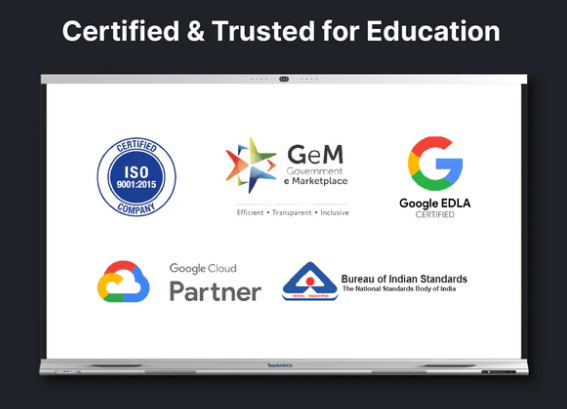Education is evolving faster than ever. Gone are the days when chalkboards and whiteboards defined classrooms. Today, technology has taken center stage – and leading this change is the digital board for teaching.
But with so many options available, how do schools, colleges, and coaching centers know which one to choose? The right digital board can transform classrooms into immersive experiences, while the wrong choice may end up as an underutilized gadget. If you’re exploring options, a good starting point is looking at a trusted digital board for teaching that balances affordability, features, and long-term value.
This step-by-step guide will walk you through exactly how to select the best digital board for teaching, ensuring your investment delivers better learning outcomes for students and ease of use for teachers.
Step 1: Understand Your Classroom Needs
The first step is clarity. Every classroom is unique, and the right choice depends on:
- Size of the classroom: Smaller rooms may need 55-inch boards, while larger classrooms benefit from 75-inch or more.
- Student strength: A large group requires clear visuals and wider viewing angles.
- Teaching style: Do teachers rely heavily on multimedia, or mostly annotation?
- Curriculum demands: Science labs, math-focused classrooms, or language studies each have different requirements.
Defining needs upfront prevents overspending on unnecessary features and ensures inclusivity for every student.
Step 2: Compare Features That Matter
Not all boards are created equal. When evaluating the best digital board for teaching, pay attention to features that directly impact classroom performance:
- Interactive touchscreen: Supports annotations, drawings, and multiple users.
- Display quality: High-resolution, anti-glare screens ensure clarity from any angle.
- Connectivity: Wi-Fi, HDMI, and USB allow easy integration with devices.
- Software ecosystem: Preloaded teaching apps, cloud integration, and collaboration tools.
- Durability: Scratch-resistant glass and long-lasting hardware for daily classroom use.
Boards with these features serve as powerful modern education tools rather than just oversized screens.
Step 3: Evaluate the Digital Board for Teaching Price
Cost is always a factor, but it shouldn’t be the only one. The digital board for teaching price varies by size, brand, and software. Entry-level models are cheaper but may lack durability, while premium boards deliver AI features and cloud integration at a higher cost.
The key is to measure value versus price:
- Will it last at least 7–10 years?
- Does it reduce recurring costs (projectors, bulbs, printing)?
- What warranty and after-sales service are offered?
By evaluating both short-term affordability and long-term value, schools make smarter financial decisions.
Step 4: Consider Training and Ease of Use
Even the most advanced digital board can fail if teachers struggle to use it. Choose boards with intuitive interfaces and ensure training is part of the package.
Teachers should be able to:
- Quickly annotate lessons.
- Access multimedia without delays.
- Save and share lessons via cloud.
- Conduct interactive quizzes or polls.
When technology empowers rather than intimidates teachers, classrooms thrive.
Step 5: Test for Engagement Impact
At the heart of every purchase decision lies one question: Will this board improve student engagement?
The right board should enable:
- Real-time collaboration: Multiple students interacting on the board.
- Multimedia lessons: Videos, animations, and 3D models to simplify complex topics.
- Gamified learning: Quizzes and activities that keep students excited.
Boards that encourage student engagement ensure that the investment translates directly into better learning outcomes.
Step 6: Compare the Best Digital Board for Teaching Options
To narrow down your choice, create a comparison checklist:
- Size: 55-inch vs 75-inch.
- Software: Basic vs AI-enhanced tools.
- Durability: Standard vs scratch-resistant build.
- Support: Basic warranty vs extended service.
- Price: Budget vs premium.
If you’re evaluating trusted solutions, you can explore the best digital board for teaching, which provides an excellent balance of advanced features and cost-effectiveness.
Step 7: Calculate ROI (Return on Investment)
Administrators often hesitate due to the upfront cost. However, the ROI tells a different story:
- Savings on printing & projectors: Digital boards reduce paper and equipment expenses.
- Reusable lessons: Teachers can save, share, and reuse materials.
- Reputation boost: Parents see modern classrooms as a sign of quality education.
- Higher performance: Improved results directly enhance school credibility.
Over time, the investment in a digital board pays for itself many times over.
Step 8: Avoid Common Mistakes
Schools sometimes make missteps that reduce the value of their investment:
- Choosing the cheapest option – Often lacks durability and essential features.
- Overbuying premium features – Paying for AI or AR tools that remain unused.
- Skipping teacher training – Limits effective adoption.
- Ignoring scalability – Failing to plan for additional classrooms.
Avoiding these mistakes ensures the chosen board delivers maximum impact.
The Future of Digital Boards in Education
The journey doesn’t stop with today’s features. The future will see boards integrating even more advanced technology:
- AI lesson personalization tailored to each student.
- Cloud-based global collaboration across schools.
- AR/VR integration for virtual field trips.
- Emotion recognition to adapt teaching pace.
This future positions digital boards as collaborative technology hubs, not just teaching aids.
Final Thoughts
Choosing the digital board for teaching is more than a procurement decision – it’s an investment in the future of learning. By following a step-by-step approach – understanding needs, comparing features, evaluating price, considering ease of use, and calculating ROI – schools can ensure they make the smartest choice.
And when the right decision is made, the result is powerful: engaged students, empowered teachers, and classrooms ready for the future.
The best digital board for teaching isn’t necessarily the most expensive – it’s the one that aligns with your school’s vision, budget, and educational goals. When chosen wisely, it transforms not just lessons, but lives.

